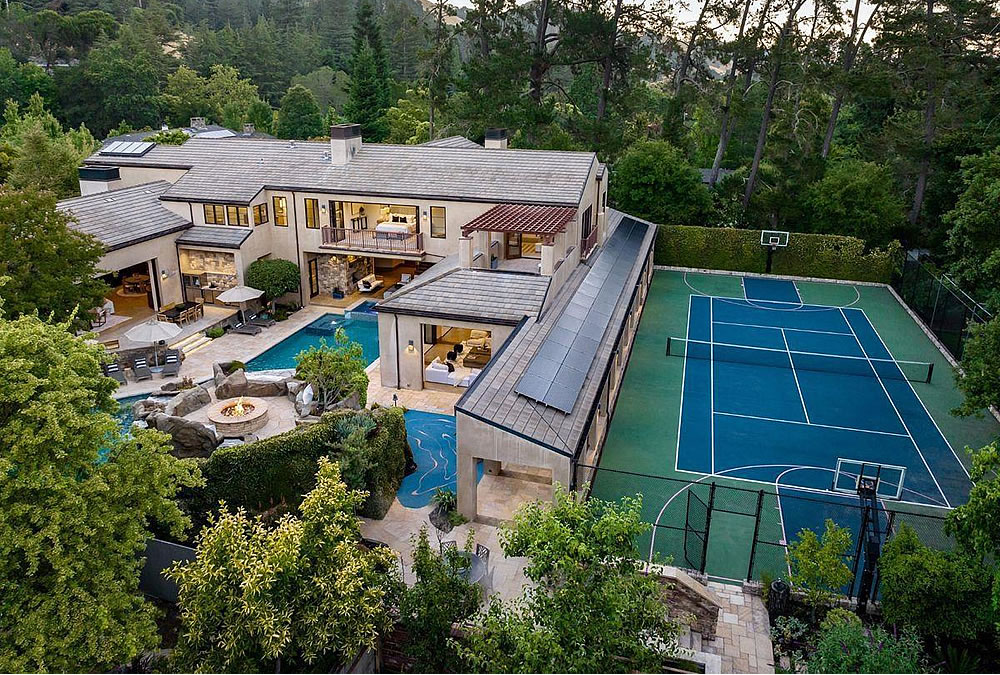As we first outlined back in 2017 when it hit the market listed for $13.500 million but failed to trade, the 8,000-plus-square-foot home at 3941 Happy Valley Road in Lafayette was built as a guest house for the founder of 24 Hours Fitness who still owns the larger 14,000-square-foot home next door, between which a fence has since been constructed.
Sitting on 2.3 acres and sited around a pool, with two spas, a poolside lanai, an outdoor kitchen, a grotto with a rooftop fire pit and an adjacent tennis/basketball court and batting cage, the now fully-separated “guest house” features an open floor plan with multiple great rooms that open to the pool and grounds and a tiered home-theater and indoor golf simulator/driving range.
While originally configured as a two-bedroom with a massive second floor gym, the home’s second floor has since been remodeled to yield an additional two bedrooms and baths.
And having returned to the market listed for $9.950 million in early 2021, reduced to $9.495 million in late 2023 and then relisted anew for $9.495 three months ago, the list price for 3941 Happy Valley Road has just been dropped to $8.495 million, a sale at which would be considered to be “at asking” according to all industry stats and aggregate strength of the market reports.







Looking at the overhead view from the previous SS posting and Google map view, this is the worst site planning I’ve ever seen. Everything is jammed together – the two houses, the pool and the tennis court. Not much design thought went into the future possibility of splitting off the guest house. Both properties are diminished.
I was thinking the same thing: feels very cramped at this exorbitant price.
“Worst site planning you’ve ever seen” is deeply on-brand for Lafayette.
Preach!
I’ve always wondered how executives at private companies can amass dynastic levels of wealth while running what are essentially low margin service businesses (because I’ve worked for a couple of these and I’m a former member at 24 Hour Fitness). From May 30, 2014, 24 Hour Fitness Sale Completed to AEA Investors, Ontario Teachers’ Pension Plan:
According to the company’s wikipedia page, after COVID-19 forced gym closures and ravaged the fitness club industry in 2020, the company filed for bankruptcy in June 2020, closed over 100 clubs, and successfully emerged from bankruptcy under new owners…but by that point, it didn’t matter, the founder had his money.
While all that is interesting – I guess (or maybe, perhaps) – it doesn’t really answer the question, does it (it just kicks its down the road: “Why does an acquirer pay dynastic levels of money for a low margin service business?”) The answer is “volume”…even a low margin, when multiplied by a huge number, equals a large number.
Pre-pandemic lockdown era, gyms were considered desirable retail tenants by landlords, because they provided a service that amazon would never be able to duplicate. They also prefer long 10 year leases, and don’t like to move around when lease comes up for renewal, because the equipment weighs tons literally, and they require specialized plumbing for locker-rooms. But they got crushed by pandemic lockdown. Interesting though that many of their former spaces are now occupied by different competing gyms. If landlords would have given 24 Hour Fitness some creative lease terms to survive the pandemic lockdown, they could still be in their same locations doing the same things. Landlords didn’t gain anything by kicking out 24 Hour Fitness, maybe landlords could only collect 10 cents on the dollar what they were owed from tenant in default. Landlords should have been more flexible with lease restructuring.
I think in many case “desireable” = “wllling and able”: i.e. they took spaces that otherwise would sit vacant. (I know in Oakland they took over the space once occupied by Joseph Magnin – who? ask your parents – and it’s not unreasonable to think otherwise that space would be vacant…maybe for decades) Financial districts have never really been strongholds for retail, but still there were a lot of banks, ticket agencies, etc.; uses that mergers and technology have often eliminated. Gyms, OTOH, meshed nicely with fitness trends…at least as long as workers were nearby.
24 Hour Fitness blowout included suburban markets. There will always be advantages and disadvantages to various different market locations for a nation wide business. The virus hysteria has faded. Even though the vax fades over time, most americans aren’t getting booster. Gyms are back in business and doing fine. I’m member in gym that was former 24 Hour Fitness space. Remodeled with newer better equipment. Not open 24 hours though which probably never made sense except for the most dense markets. Nobody wants sauna or whirlpool any more, considered not sanitary. IMO many commercial landlords were shortsighted, and should have restructured their commercial leases, giving tenants rent break during lockdown, then allowing them to pay it back with interest after lockdown. A tenant in the hand is worth more than 2 or 3 in the bush, considering the lost rent of vacant space while the landlord finds replacement tenant. Not to mention the damage to the perception of the property with a big vacant space with boarded over windows.
Notcom, you’re right, I was just looking at the same transaction, but on the wrong ledger. Thanks for sharing your thoughts.
cry babies. that’s a nice ADU
Much smaller subset of buyers of unique properties.